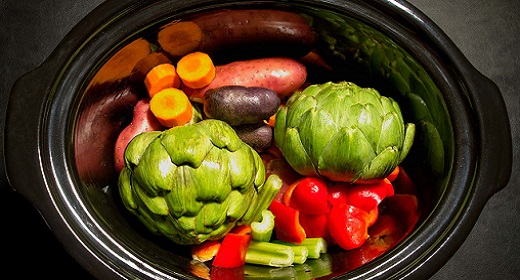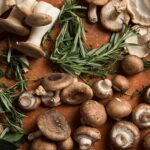by Howard Garrett: Organic growing techniques have been practiced for as long as humans have tilled the earth…
Only since World War II has agriculture become dependent upon toxic synthetic fertilizers and pesticides. These man-made chemicals temporarily increased the yield of many crops, but also increased the long-term cost of production, caused air and water pollution, changed soil structure, and jarred the entire ecosystem.
Organic fertilizers, whether they’re meals, manures, or composted plant material, contain N-P-K (nitrogen-phosphorus-potassium), trace minerals, enzymes, vitamins, and lots of organic matter. Of those ingredients, 100% are useful to the soil and plants. In contrast, synthetic fertilizers contain no organic matter. Soil microorganisms must have this carbon energy source, and, if it isn’t provided, the microbes will take it from the soil. That drains soil health with every fertilizer application.
Unlike synthetic fertilizers, organic fertilizers don’t create high levels of salts, such as nitrates, which disturb or even kill beneficial soil organisms. Organic fertilizers release nutrients slowly and naturally. (See my chart, Best Natural Organic Fertilizers, for a rundown.) All components are usable by the plants, because organic fertilizers don’t contain useless fillers as with synthetic fertilizers.
Feeding the soil and plants with nothing but N-P-K is like feeding your kids nothing but soda. Soil and people need a balance of nutrients. For some unknown reason, fertilizer recommendations continue to emphasize these three nutrients with special emphasis on high levels of nitrogen. Studies have shown that 80% or more of all synthetic nitrogen applied to the soil will be volatized or leached out, and the 10% to 20% that does reach the plant will be harmful. Other studies show that an excess of chemical fertilizer slows or even stops the activity of microflora and microfauna, such as beneficial bacteria, algae, fungi, and other microorganisms. Harsh fertilizers also cause damage to macroorganisms, such as earthworms, millipedes, and centipedes, which are extremely important to the natural processes in the soil.
The most important material in an organic garden is organic matter that becomes humus during the decomposition process. Humus becomes humic acid, other beneficial acids, and mineral nutrients. Organic fertilizers are better than artificial products because they’re the derivatives of plants and animals and therefore contain most or all the trace elements that exist in growing plants and animals. In addition, organic fertilizers are naturally slow-releasing and provide nutrients to plants when they need it. Synthetic fertilizers glut the plants with nutrients immediately after application, which is usually at the wrong time.
Here are my recommendations for the best natural, organic fertilizers to boost your garden’s production and build soil health.
This chart summarizes the N-P-K ratio and the benefits of most of these soil-boosting amendments.
Alfalfa meal provides many nutritional benefits for plant use and soil organisms. One very important ingredient is triacontanol, a powerful plant-growth regulator. Alfalfa is very high in vitamins, plus N-P-K, calcium, magnesium, and other valuable minerals; sugars and starches; proteins; fiber; and 16 amino acids. Use at 10 to 20 pounds per 1,000 square feet. See recipe at the end of this article for making alfalfa tea with alfalfa meal.
Bat guano is a natural all-purpose organic fertilizer containing nitrogen and lots of trace elements. It has natural fungicidal qualities and almost no chance of being contaminated with pesticides or chemicals. Best to apply once or twice during the growing season. Be careful not to overuse, because it contains up to 10% nitrogen.
Blood meal is an organic source of nitrogen and phosphorous. Expensive, but good to mix with cottonseed meal.
Bone meal is a source of calcium and phosphorous recommended for bulbs, tomatoes, and other vegetables. Rock phosphate is better and cheaper.
Chelators are organic compounds with attached inorganic metal molecules, which are more available for plant use. Chelated iron and other chelated nutrients are used when a direct dose of a particular nutrient is needed to quickly solve a deficiency. Compost, humus, humic acid, and microorganisms have natural chelating properties.
Coffee grounds. Apply old coffee or grounds directly to the soil in beds or potted plants. Both are acidic and loaded with nutrients, including N-P-K.
Compost is the best organic fertilizer and is key to any organic gardening program. It’s high in nutrients, humus, humic acid, and microorganisms. Analysis will vary based on ingredients. The best composts are made from a variety of local organic materials, such as hay, sawdust, manure, leaves, twigs, bark, wood chips, dead plants, food scraps, pecan hulls, and grass clippings.
Corn gluten meal is a natural weed-and-feed fertilizer. Broadcast in spring to prevent crabgrass and other annual weeds. For cool-season or winter weeds, broadcast again in fall at 15 to 20 pounds per 1,000 square feet for the control of henbit, dandelions, annual bluegrass, and more. Make sure the product you buy contains 60 percent protein.
Cornmeal functions as natural fungal-disease control when used on soil or in bed preparation. Apply at 10 to 20 pounds per 1,000 square feet to prevent damping off and leaf spot diseases. Grocery store cornmeal isn’t as effective as whole-ground organic cornmeal.
Earthworm castings are high in bacteria, calcium, iron, magnesium, sulfur, and N-P-K, and have more than 60 trace minerals. They’re an excellent ingredient in potting soil, in flats when germinating seeds, and to toss into planting holes. They’re gentle, sweet-smelling, and clean.
Fish hydrolysate (liquid fish). Use this concentrated liquid fish fertilizer directly in the soil or as a foliar feed. It’s reportedly an effective insecticide, and it’s a good all-purpose spray when mixed with liquid kelp. It has an odor for about 24 hours. (Fish emulsion is no longer recommended because of the processing method.)
Fish meal is excellent for all plants, but it’s usually expensive and also stinky.
Granite sand is sand-like residue from granite quarry or natural deposits. It’s a great way to add minerals to planting beds. It contains potash and many trace minerals.
Greensand is a naturally mined material called glauconite, which is a naturally deposited undersea, iron-potassium silicate. It’s an excellent source of iron and other trace minerals. It’s best used with other fertilizers and organic materials, and contains 14 to 20 percent iron.
Gypsum is a natural soil amendment material (calcium sulfate) that’s approximately 23 percent calcium and 17 percent sulfate. Gypsum neutralizes plant toxins, removes sodium from the soil, and opens soil structure to promote aeration and drainage. It’s not often needed in high-calcium soils.
Humates are basically low-grade lignite coal and are an excellent source of carbon, humic acid, and trace minerals. The percentage of humic acid will vary. Humates are available in liquid and dry forms.
Hydrogen peroxide is an oxidizing liquid for use on soil in diluted amounts. Dangerous in concentrated forms, hydrogen peroxide should be used at a 3 percent formulation to help aerate and flocculate the soil. Do not continue to use hydrogen peroxide.
Kelp meal is a dry fertilizer that’s made from seaweed. Its approximate analysis is 1-0-8, with many trace minerals and plant hormones that stimulate root growth and regulate plant growth. Provides soil conditioning, improves crumb structure or tilth, and helps stimulate microorganisms.
Lava sand is waste material left from lava gravel processing. It can be used as a natural soil amendment in potting soils and bed preparation for all landscaping and food crops. Lava sand isn’t needed in volcanic soils.
Lime. Dolomitic lime contains 30 to 35 percent magnesium. High-calcium lime (calcium carbonate) is preferred because most low-calcium soils have plenty of magnesium.
Manure. The following manures can be applied directly without fear of burning plants: rabbit, llama (aka “llama beans”), and alpaca. These manures should be composted prior to use because of their high nitrogen content: cow, horse, sheep, turkey, and chicken. When composting, mix manure with leaves, sawdust, straw, and other vegetative material. Use chicken litter from your own birds or from a grower you trust because commercial chickens are fed many unnatural things, including arsenic.
Micronized products can be mixed with water and sprayed on foliage or drenched into the soil. They tend to be highly bioavailable.
Mineral products are excellent natural amendments for most soils. Many contain rocks, including lava sand, basalt, granite sand, rock phosphate, humate, and montmorillonite.
Molasses is a carbohydrate used as a natural soil amendment to feed and stimulate microorganisms. It contains sulfur, potash, and many trace minerals. The liquid form of molasses is used in sprays. Dry molasses is an ingredient in many organic fertilizers.
Rock phosphate is an economic source of natural phosphorus and calcium, formed in oceans. It’s used mainly for edible crops and flowering plants, and helps promote photosynthesis and deter weeds. Use full-strength for germinating seeds.
Root stimulators. This generic term refers to mild fertilizers or any material that stimulates microbial activity and root growth. Liquid seaweed, vinegar, molasses, and compost tea also function as root stimulators. Most commercial root stimulators are simply liquid synthetic fertilizers and shouldn’t be used.
Seaweed is best used as a foliar spray, and is an excellent source of trace minerals. This natural organic fertilizer should be used often. It contains hormones that stimulate root growth and branching. Seaweed functions as a mild but effective insect control, especially for whiteflies and spider mites. It acts as a chelating agent, making other fertilizers and nutrients more bioavailable to plants.
Sul-Po-Mag is a naturally occurring mineral containing 22% sulfur, 22% potash, and 11.1% magnesium — an excellent specialty product for any organic gardening program.
Sulfur is a basic mineral often lacking in alkaline soils. Apply granulated sulfur at 5 pounds per 1,000 square feet twice annually to help lower base saturation of calcium and raise magnesium. Be careful not to breathe dust, over-apply, or use when planting seed. Can act as a pre-emergent. It should not be used in acidic soils.
Garrett Juice Fertilizer
You can make my recipe for this foliar feeding spray and soil-fertilizer mixture at home.
1 gallon water
• 1 cup manure compost tea or liquid humate
• 1 ounce molasses
• 1 ounce apple cider vinegar
• 1 ounce liquid seaweed
Directions
Mix all ingredients together. For foliar feeding, use the concentrate with water at 2 to 3 ounces per gallon and use on all plants. Spray any liquid materials during the cooler parts of the day. For soil treatment, double the application rate.
Alfalfa Tea Recipe
Put 1 cup alfalfa meal into a 5-gallon bucket, fill bucket with water, and let it sit overnight. Apply this thick tea generously to the root area of shrubs and flowers, or use as a foliar spray after straining away the solids. Use it quickly because this mixture gets stinky if it sits around too long.










































